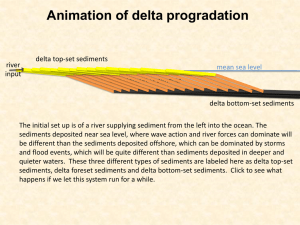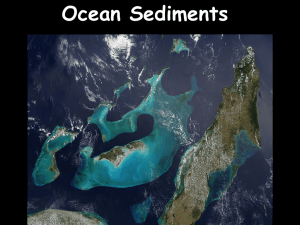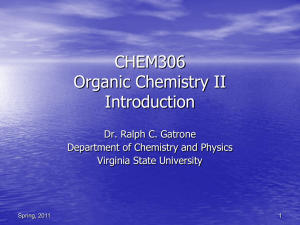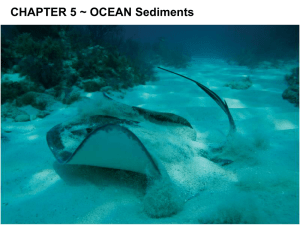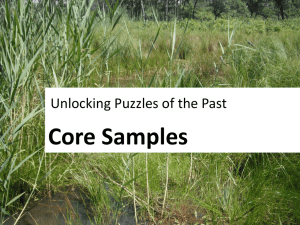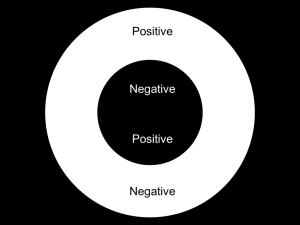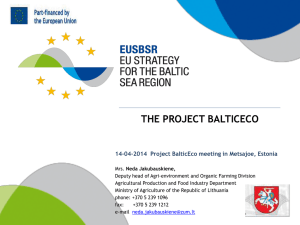PPT
advertisement
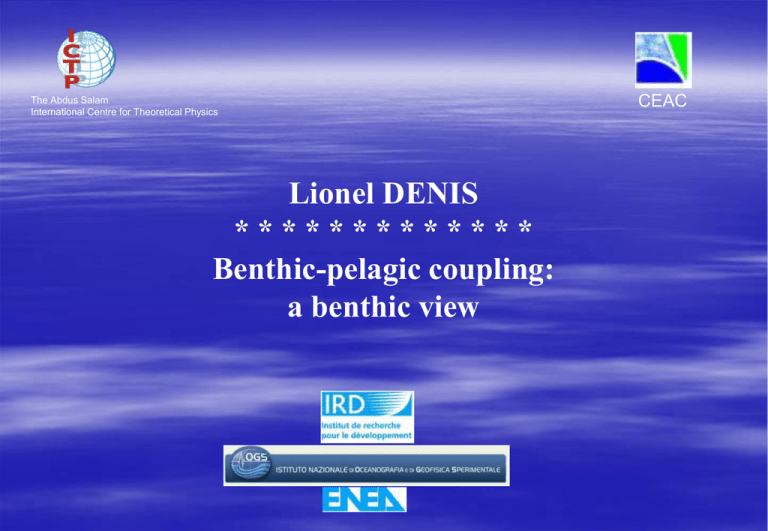
The Abdus Salam International Centre for Theoretical Physics Lionel DENIS ************* Benthic-pelagic coupling: a benthic view CEAC ************* Benthic-pelagic coupling: a benthic view I – Historical review II – Main coupling factors 1 – Organic Matter input in surficial sediments 2- Resuspension processes 3 – Nutrient recycling 4 – Contaminant sequestration III – Close to the coast… the history changes Sources of Organic Matter to the ocean: Input type Oceanic Primary production -Phytoplankton -Macrophytes Liquid inputs - Rivers - Groundwater Atmospheric inputs - Rain - Dry particles Total Quantity (1015gtC.y-1) Percent 90.6 23.1 1.7 84.4 6.2 3.95 1.0 0.08 3.65 0.3 5.45 1.0 0.5 3.65 1.8 27.4 100 Microphytobenthos, Thermal vents (<0.1%) 100 ************* Benthic-pelagic coupling: a benthic view Historical review Until the 70-80’s : « Organic matter flux from the pelagic to the benthic system can be considered as a constant ‘rain’ of particles sinking vertically onto the surficial sediments. » (Steele, 1974) No coupling between compartments Few works demonstrated a different mechanism : «In Kiel Bight, sediments collected during the spring were covered with a green layer probably originating pelagic diatoms. » (Remane, 1940) « In several lakes, we have demonstrated the influence of planktonic input in spring and automn on the development of Chirinomidae larvae in surficial sediments.» (Jonasson, 1964) Coupling between compartments Hargrave (1973) : First described a model where sediment oxygen consumption was directly linked to pelagic primary production. Depth is also a key parameter This study was based on a wide variety of systems (oligotophic, eutrophic, coastal, lakes, …) Hargrave’s model (1973) Kiel Bight : All primary production is mineralized in surficial sediments Further details with developping technology AIR Sediment traps ST 80 m ST 900 m Depth 930 m Location : Mediterranean Sea – Grand Rhône Canyon - Single Depth 80 m Large seasonal variability due to fluctuations in the primary production in surface waters TEMPORAL VARIABILITY Location : Mediterranean Sea – Grand Rhône Canyon – Several depths from 80 to 900 m Maximal inputs at a depth of 600 m ? Several other processes than only 1DV settling contribute to the input of Organic Matter on surficial sediments (vertical) Settling Advective transport Resuspension ************* Benthic-pelagic coupling: a benthic view II Main forcing factors 1 – Organic Matter input in surficial sediments Organic matter input depends on 4 main parameters Depth Decay rate of Organic Matter Settling velocity Disequilibrium between production and consumption in surface waters Depth: - Shallow sediments: HIGH COUPLING - Deep- sediments: LOW COUPLING Decay rate of organic matter: Depends on the quality of Organic Matter. Modified during the settling Origin C/N ratio Redfield ratio: BACTERIA 4-6 PHYTOPLANKTON (CH2O)106(NH3)16(H3PO4) 6.6 SENESCENT PHYTOPLANKTON C/N/P = 106/16/1 7.5 ZOOPLANKTON SEDIMENTS (1st cm) SEDIMENTS (10th cm) 8.5 10 40 Particle diameter: - Larger particles have higher settling velocities - With degradation processes, large molecules are transformed in smaller molecules Aggregates - Decrease the surface of contact with ambient water, hence decreasing the opportunity of bacterial degradation , - Diameter increase may be consecutive to the trophic network (faeces of zooplankton / phytoplankton) Diameter (µm) Settling velocity(/day) 20 µm 38 m 1 µm 6 cm 0.05 µm 0.4 mm Disequilibrium between production and consumption in surface waters: When production of surface waters is highly variable in time => pulse inputs towards deeper waters Surface production - Primary production - Production of higher trophic levels DEGRADATION MINERALIZATION RECYCLING in the euphotic zone Strong gradients Physical barrier to vertical transfer Surficial sediments THERMOCLINE HALOCLINE Dystrophic events Vertical export from surface waters is too high / consumption in surficial sediments SEDIMENTWATER INTERFACE Surface production Consumption Food limitation Equilibrium Equilibrium Too much Organic Matter=> Disequilibrium => Bacteria=> Anoxia => Death of several organisms OTHER BIOLOGICAL PROCESSES - Coastal sediments: Filtration activity Cloern, 1982: 202. Does the benthos control phytoplankton biomass in San Francisco Bay? MEPS 9: 191- - Deep-sea sediments: Migratory behavior (night/day cycles) Several Crustacean species demonstrate a migratory behavior: Surface water during the night, close to the sediment during daylight. ************* Benthic-pelagic coupling: a benthic view II Main forcing factors 1 – Organic Matter input in surficial sediments 2- Resuspension processes Resuspension processes: Directly linked to current velocity close to the sediment 2 main parameters to calibrate resuspension processes Critical shear stress Above this value, particles are resuspended Erosion rate The amount of particles resuspended per unit time. Resuspension processes: Mainly: Sediment particles (Inorganic, Organic aggregates, dead organisms) Microphytobenthos Either fixed on particles or free but resuspended Macrophytes The distal part of macrophytes is regularly cut by waves and movements on rocks Macrobenthic organisms Either larval stages, or adults (Polychaetes). Inorganic resuspension Flume experiments Comparison Inorganic/ Organic resuspension Fluorimeter Sediment Test section Turbidimeter Peristaltic pump Concentration de pigments totaux (µg.l ) totaux (µg.l ) } } Pigment content (µg/l) -1 -1 90 40 -1 -1 -1 -1 -1 -1 -1 5 cm.s 10cm.s 15cm.s 20cm.s 25cm.s 30cm.s 0cm.s 80 35 70 30 M.E.S. S.P.M. 60 25 50 20 40 Pigments Totaux 15 30 10 20 5 10 0 0 0 20 40 60 80 100 120 140 Concentration de pigments Velocity increased step by step Critical erosion velocity: 15-20 cm.s-1 en suspension (mg.l ) Thau lagoon Muddy sediments Concentration de matière content (mg/l) SPM Comparison Inorganic/ Organic resuspension -1 35 0,40 30 0,35 25 0,30 0,25 20 0,20 15 10 5 Free-stream velocity Vitesse du courant SPM M.E.S. 0,15 Pigmentstotaux Pigments 0,05 0,10 0 0,00 0 20 40 60 Temps (minutes) Time (minutes) 80 100 Pigment content -1(µg/l) Muddy sand Gradual increase of velocity Critical erosion velocity: 16.5 cm.s-1 en Suspension (mg.l ) Gulf of Fos -1 and (mg/l)(cm.s content SPM Vitesse ) de courant (cm/s) velocity free-stream Concentration de Matière Temps(minutes) (minutes) Time Macrophytes Resuspension (storms) March Growth during year n Growth zone Figure 36: Morphology and growth of Laminaria saccharina (Year 2001) May v June v Total length (cm) Growth during year n-1 April Expected length Measured length Days Figure 37: Measured l and Expected length of the macroalgae Laminaria saccharina (Year 2001) v ************* Benthic-pelagic coupling: a benthic view II Main forcing factors 1 – Organic Matter input in surficial sediments 2- Resuspension processes 3- Nutrient recycling Euphotic layer Organic Particulate Matter CO2 Settling Resuspension Nutrient recycling NO3-, NH4+ , PO43-, Si(OH)4 WATER COLUMN SEDIMENT-WATER INTERFACE Accumulation ?Mineralization SURFICIAL SEDIMENT Refractory Organic Matter ************* Benthic-pelagic coupling: a benthic view II Main forcing factors 1 – Organic Matter input in surficial sediments 2- Resuspension processes 3- Nutrient recycling 4- Contaminant accumulation Organic Particulate Matter + bounded contaminants Settling Bio-available Contaminants WATER COLUMN Resuspension SEDIMENT-WATER INTERFACE Accumulation Immobilized ? contaminants -Bounded - Non-toxic form -- Non bio-available (too deep) Bioturbation SURFICIAL SEDIMENT ************* Benthic-pelagic coupling: a benthic view III Close to the coast…the history changes… Example: Benthic mineralization processes and consequences close to the mouth of two major french rivers: the Seine and the Rhone rivers Problematics Benthic mineralization in estuaries -Benthic mineralization plays an important role in estuarine coastal systems: -A large part of organic matter degraded in surficial sediments -Serious consequences of those processes (nutrient release / eutrophication, hypoxic events, Pollutants accumulations, transformations or releases,...) - Numerous problems remain because of the complexity of such environments (natural versus human activities, riverine / open sea influence, resuspension, coastal installations, pollution,...) Problematics – Estuaries Riverine discharge Nutrient concentration Tidal cycles Coastal topography Coastal eutrophication Dredging activities Are biogeochemical data a useful tool to identify the main forcings in an estuarine system? => Oxygen microprofiling Coastal hydrodynamics Littoral constructions River mouth embankment Site presentation - Bay of Seine N 49.30 Winter flooding period - High river discharge - Wave action limited → Dispersion of suspended matter towards open sea (W -NW) 49.28 49.26 49.24 00 W -0.02 0.02 Spring storms Summer low water periods 0.00 0.02 0.04 0.06 0.08 0.10 0 0 0.12 0 0 5 0 km 0.16 E 0.14 N 49.30 49.28 - Large wave action / resuspension - Low river discharge → Accumulation of suspended matter in the north and south of the dykes 49.26 49.24 00 W -0.02 0.02 0.00 0.02 0.04 0.06 0.08 0.10 0.12 0 0 0 0.14 0 5 0 km 0.16 E Sampling strategy N 49.30 -25 Stations 49.28 all around the mouth 49.26 of the Seine river 49.24 00 W -0.02 0.02 - 2 cruises 18-19 September 2003 0.02 0.04 0.06 0.08 0.10 0.12 0 0 0.14 2000 Flood period Daily averaged discharge (m3.s-1) 26-27 February 2003 0.00 0 Low water period 1000 0 J F M A M J J 2003 A S O N D 0 5 0 km 0.16 E Sampling strategy -For each station N 49.30 1- Reineck Boxcores with overlying water 49.28 49.26 2- Subsampling with low-diameter cores 49.24 00 3b- Core slicing (1cm) for porosity (drying), OC and ON (CHN autoanalyzer) measurements in triplicates W -0.02 0.02 0.00 0.02 0.04 0.06 0.08 0.10 0.12 0 0 0.14 2000 Flood period Daily averaged discharge (m3.s-1) 3a- Direct measurements of 4-6 oxygen microprofiles 0 Low water period 1000 0 J F M A M J J 2003 A S O N D 0 5 0 km 0.16 E Oxygen Microprofiling All measurements were performed Oxygen microelectrodes - on board - in the dark - Polarographic Clark type microsensors - immediatelly after retrieval - Tip diameter 100µm Motorized micromanipulator Thermometer Motor controller Computer Picoammeter Oxygen microelectrodes Sediment core Strirring system (bubbling) Typical oxygen profiles Oxygen concentration (µM) 0 50 100 150 200 Station SAS04 250 0 September Cruise Profile n°1 Profile n°2 2000 Muddy sediment Profile n°3 Profile n°4 Porosity (1st cm): 0.68 4000 Oxygen concentration (µM) 6000 -5000 Station SAS24 September Cruise Sandy sediment Porosity (1st cm): 0.39 Depth in the sediment (µm) Depth in the sediment (µm) -2000 0 50 100 150 200 250 0 5000 10000 15000 20000 25000 Profile n°1 Profile n°2 Profile n°3 Profile n°4 Diffusive oxygen fluxes calculations Depth in the sediment (µm) O xygen concentration (µM) -400 -200 0 0 200 400 600 800 1000 50 100 150 200 250 Benthic Oxygen Demand (BOD): C/z BOD = . Ds . (C/z) z=0 - Function of temperature and salinity Station SAS04 - Modified method of Sweerts et al. (1989): Depth in the sediment (µm) Oxygen concentration (µM) -2000 50 -1000 0 0 1000 2000 3000 4000 5000 6000 Station 100 150 200 250 C/z SAS24 Location of the Sediment-Water interface as a break in the oxygen concentration gradient Slope calculation averaged on five successive data points in the gradient SA 0 SA 3 0 SA 4 0 SA 5 0 SA 6 0 SA 7 0 SA 8 0 SA 9 1 SA 0 1 SA 6 1 SA 8 1 SA 9 2 SA 0 2 SA 1 5 SA 1 5 SA 2 5 SA 3 5 SA 5 6 SA 2 6 SA 4 87 SA SA F S SA 04 S SA 06 S SA 17 S SA 18 S SA 20 S2 4 Benthic Oxygen Demand (mmol.m-2.d-1) February September Stations 6.9-7.5 °C 19-21.3 °C Sediment temperature 25 20 15 10 5 0 Correlation BOD - Porosity Average BOD (mmol.m -2.d-1) R2=0.68 18 16 14 12 10 8 6 4 2 0 0.3 0.4 0.5 0.6 0.7 0.8 0.9 Porosity Sandy Stations Muddy Stations Organic Carbon (% Dry Weight) Correlation Porosity – Organic Carbon R2=0.92 4 3 2 1 0 0.3 0.4 0.5 0.6 Porosity 0.7 0.8 0.9 Organic Carbon & Benthic Oxygen Demand Major differences with the Rhone river Seine river 79 000 km2 780 km 410 m3.s-1 7m Catchment area Length Mean discharge (Poses) (Beaucaire) Tidal range Rhône river 97 000 km2 810 km 1800 m3.s-1 0.1 m Rhone river -General hydrodynamic forcing easily described North -Clear gradient of OC and consequently of Mediterranean benthic mineralization processes Current Benthic Oxygen Demand 3 43°24’ 43°21’ 2,5 R1 43°18’ 2 1,5 R2 43°15’ 1 43°12’ S 43°09’ (mmol.m-2.d-1) 4°39’ 4°42’ 4°45’ 4°48’ 4°51’ 4°54’ 0,5 4°57’ % Organic Carbon 25 20 15 10 5 0 S R2 R1 Seine river -Complex hydrodynamic features - Local organic matter accumulation -Patchwork of Benthic mineralization processes N 49.30 49.28 49.26 49.24 00 W -0.02 0.02 0.00 0.02 0.04 0.06 0.08 0.10 0.12 0 0 0 0.14 0 5 0 km 0.16 E Riverine Discharge Tidal Range Daily averaged discharge (m3.s-1) 12000 10000 Seine River 8000 Rhône River 6000 Tidal Range 4000 2000 0 94 95 96 97 98 99 00 01 02 03 94 95 96 97 98 99 00 01 02 03 Monthly averaged discharge (m3.s-1) (1994-2003) 3000 Annual input of SPM 0.4 to 1.1 x106 t.y-1 Annual input of SPM 2000 1.7 to 22.7 x106 t.y-1 1000 0 J F M A M J J A S O N D Continental shelf topography Distance from river mouth (km) Depth (m) 0 20 0 10 20 30 40 Seine River 40 60 80 100 50 Rhône River Conclusions In the Bay of Seine No general seasonal change of benthic mineralization High variability at low spatial scale Efficient dispersion towards west, accumulation in the south of the southern dyke Rhône River / Seine River Comparison Gradual dispersion of organic matter for the Rhône River Dispersion of organic matter for the Seine River but also local redistribution and consequently higher impacts of accumulation areas and coastal installations Thank you for your attention…
